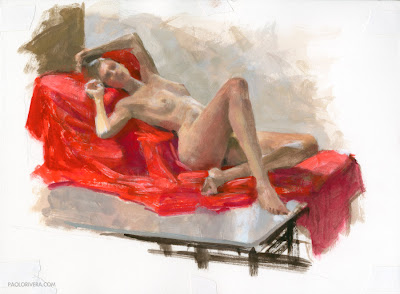 |
| Figure Painting Detail (Session 2 of 3). 2010. Gouache, watercolor, and acrylic on paper, 12 x 9". |
Round 2 of figure painting went well, marking the first foray into color. I concentrated on the overall tones of the image, leaving any detail for next week. I'm going to attempt to retain the looseness of this first pass during the next session, but no promises. I'll probably be happier with the results if I just treat it as a "study." It might help if I stick to my chosen brush, a #4 filbert, hog bristle.
I am often asked why I mix media so readily, never settling for a single approach. This painting serves as a reasonably good example of how different mediums can be utilized for their unique properties. The red fabric, for instance, is rendered with a gouache and watercolor underpainting, but the highlights are "plucked" from the shadows with white acrylic, topped with a thin coat of red acrylic (Holbein's Scarlet Acryla Gouache, to be exact). The result is a red that is light in tone, yet deeply saturated. Even when used at full strength, the red acrylic could not physically reproduce the same effect. You can still see "unvarnished" white in some areas, such as the fingers, elbow and left calf. These hot spots were laid down in preparation for future color passes.
Most of the other strokes are gouache and watercolor, both of which I readily mix together, depending on the desired consistency. I actually forgot to bring my palette knife to the studio, but the colors of the scene were limited enough as to not present a challenge. It would have been a different story had the painting been larger.
Just for the record, my favorite part is her left foot. Dirty feet is one of the unspoken joys of painting from life. Have a great weekend!


Awesome study.
ReplyDeleteDoes mixing the watercolor and gouache create any sort of weird side-effects in terms of how the paint or color handles? I know they're practically one and the same, so it'd seem like there wouldn't be much benefit to it beyond maybe some added color saturation with some increased flow.
The weird side effects are what I'm going for. The slightest change can make a huge difference, especially when rendering skin tones. Things like mass tone and undertone play a significant role in color, and that is modulated in large part by paint consistency.
ReplyDeleteDespite all that, many of the benefits were lost on me this past session because I had forgotten my palette knife. Mixing by brush tends towards a uniform consistency, no matter the medium.
There are three or four painters in my little impromptu class that i attend and they are really good...thus far i have only been doing these quick charcoal studies that are done in 10minute intervals....you have inspired me to branch out a little and try painting on my next session...i will most likely just work with acrylics in black and white til i get a feel for it....can't wait for Wednesday now! Here are a few of my past charcoals if you are interested...
ReplyDeletehttp://ddsketchbook.blogspot.com/search/label/Charcoals
I visited your blog, thank you very much. Visit you will also see my art and photos from Finland. Autumn Greetings Markku Mäkelä.
ReplyDeleteI usually appreciate better your pencilled works, rather than the painted ones.
ReplyDeletebut, this time, I really love what you've done and, most of all, the way you've modulated.
Looks great Paolo! Love to see some more of figure painting.
ReplyDelete